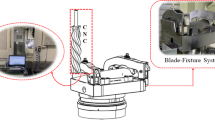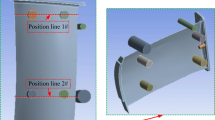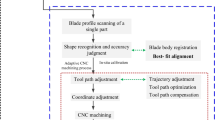Abstract
Near-net-shaped jet engine blade machining process have better performance on both reducing material waste during production and improving work reliability in service, while precision machining of this blade is very challengeable and difficult due to its positioning difficulty and low stiffness. This paper propose that reasonable fixture and adaptive CNC machining technology can provide a systematic solution for the machining of near-net-shaped blade Tenon root, tip and Leading edges and Trailing edges (LTE). Firstly, process characteristics, difficulties and requirements of near-net-shaped blade are analyzed. Secondly, adaptive CNC machining process and its key technical principles are introduced and optimized, and proposes measuring bad points culling algorithm of simultaneously using distance relationship, angle relationship and radius relationship, and proposes camber line calculation algorithm of equidistant offset, and optimizes the iterative closest point (ICP) algorithm based on point-to-line ICP algorithm with six control points, and realizes the reconstruction of processing model. Finally, the feasibility of the proposed adaptive CNC machining process and the designed Polyetheretherketone (PEEK-GF30) material and multi-points support rigid-flexible coupling fixture are verified by a typical near-net-shaped blade LTE and Tenon root adaptive CNC machining process experiments. The results shows that the proposed process scheme of reasonable fixture and adaptive CNC machining process can solve two problems of near-net-shaped blade manufacturing of position difficulty and low stiffness. The designed fixture of PEEK-GF30 material and multi-point support rigid-flexible coupling, and the optimized adaptive CNC machining process algorithms can realize high-precision manufacturing of near-net-shaped jet engine blade.


































Similar content being viewed by others
References
Ahmed, E., Soumaya, Y., Mohamed-Salah, O., & Yasser, S. (2019). Failure time prediction using adaptive logical analysis of survival curves and multiple machining signals. Journal of Intelligent Manufacturing. https://doi.org/10.1007/s10845-018-1453-4.
Alexa, M., Coheror, D., & Levin, D. (2002). As rigid as possible shape interpolation. Computer Graphics,34(1), 157–164.
Besl, P. J., & Mclay, N. D. (1992). A method for registration of 3D shapes. IEEE Transactions on Pattern Analysis Machine Intelligence,14(2), 239–256.
Bradley, G., & Vickers, G. W. (2002). Automated rapid prototyping utilizing laser scanning and free machining. Annals of CIRP,41, 437–440.
Chatelain, J. F. (2005). A level-based optimization algorithm for complexpart localization. Precision Engineering,29(2), 197–207.
Elamaraghy, H., Bararia, A., & Knopf, G. K. (2004). Integrated inspection and machining for maximum conformance to design tolerances. CIRP Annals - Manufacturing Technology,53(1), 411–416.
Gao, J., Chen, X., Yilmaz, O., & Gindy, N. (2008a). An integrated adaptive repair solution for complex aerospace components through geometry reconstruction. The International Journal of Advanced Manufacturing Technology,36, 1170–1179.
Gao, J., Chen, X., Zhang, D. T., & Nabil, G. (2008b). Adaptive repair approach for recovering components from defects. Chinese Journal of Mechanical Engineering,21(1), 57–60.
Hebert, M., & Jairo, E. (2007). A regularization approach for surface reconstruction from point clouds. Applied Mathematics and Computation,188(1), 583–595.
Hugues, H., Tony, D. R., & Tom, D. (1992). Surface reconstruction from unorganized points. ACM Siggraph Computer Graphics,26(2), 71–78.
Kamran, J., Rafael, G., Xiang, Li, & Noureddine, Z. (2018). Tool wear monitoring and prognostics challenges: A comparison of connectionist methods toward an adaptive ensemble model. Journal of Intelligent Manufacturing,29, 1873–1890.
Katz, R., Srivatsan, V., & Patil, L. (2011). Closed-loop machining cell for turbine blades. The International Journal of Advanced Manufacturing Technology,55, 869–881.
Ko, K. H., Maekawa, T., & Patrikala, N. M. (2003a). An algorithm for optimal free-form object matching. Computer-Aided Design,35(10), 913–923.
Ko, K. H., Maekawa, T., & Patrikala, N. M. (2003b). Shape intrinsic properties for free-form object matching. Journal of Computing and Information Science in Engineering,3(4), 325–333.
Li, Y. D., & Gu, P. H. (2003). Free-form surface inspection techniques state of the art review. Computer-Aided Design,36(13), 1395–1417.
Lin, X. J., Wu, D., Yang, B., Wu, G., Shan, X., Xiao, Q., et al. (2017). Research on the mechanism of milling surface waviness formation in thin-walled blades. The International Journal of Advanced Manufacturing Technology,93, 2459–2470.
Marini, D., Cunningham, D., & Corney, J. R. (2018). Near net shape manufacturing of metal: A review of approaches and their evolutions. Proceedings of the Institution of Mechanical Engineers, Part B: J Engineering Manufacture,232, 650–669.
Mears, L., Roth, J. T., & Djurdjanovic, D. (2008). Quality and inspection of machining inperations: CMM integration to the machine tool. Journal of Manufacturing Science and Engineering,131(5), 051006–051013.
Mohaghegh, K., Sadeghi, M. H., & Abdullah, A. (2007). Reverse engineering of turbine blades based on design intent. Original Article,32, 1009–1020.
Sunil, S., & Nandihalli (2004). A B-spline geometric modeling methodology for free surface simulations. Mississippi: Mississippi State University.
Ren, J., Feng, Y., Mi, X., & Xu, Y. (2015). Adaptive CNC machining technology for precision forging blades of aeroengines. Aeronautical Manufacturing Technology,22, 52–55+59.
Sharp, G. G., Lee, S. W., & Wehe, D. K. (2002). ICP registration using invariant features. IEEE Transactions on Pattern Analysis Machine Intelligence,24(1), 90–102.
Somkiat, T. (2011). Advance in detection system to improve the stability and capability of CNC turning process. Journal of Intelligent Manufacturing,22, 843–852.
Sun, Y. W., Ming, W. X., Guo, D. M., & Liu, J. (2009a). Machining localization and quality evaluation of parts with sculptured surfaces using SQP method. International Journal of Advanced Manufacturing Technology,42(11), 1131–1139.
Sun, Y. W., Xu, J. T., Guo, D. M., & Jia, Z. Y. (2009b). A unified localization approach for machining allowance optimization of complex curved surfaces. Precision Engineering,33(4), 516–523.
Wu, X. M., & Li, G. X. (2009) A new surface reconstruction method in reverse engineering (pp. 334–338). IEEE.
Xiong, Z. H., Wang, M. Y., & Li, Z. X. (2003). A computer-aided probing strategy for workpiece localization. IEEE International Conference on Robotics & Automation,3(1), 3941–3946.
Xiong, Z., Wang, M. Y., & Li, Z. (2004). A near-optimal probing strategy for workpiece localization. IEEE Transactions on Robotics,20(4), 668–676.
Xu, J. T., Wei, J. L., & Yu, W. S. (2007). Free surface matching algorithm based on curvature feature. Journal of Computer-Aided Design & Computer Graphics,19(2), 193–197.
Yi, X., Ma, L. M., & Li, Z. X. (2008). A geometric algorithm for symmetric workpiece localization. In Proceedings of the 7th World Congress on Intelligent Control and Automation, Chongqing, China (pp. 6025–6029).
Zhang, Z., Zhang, D., Luo, M., & Wu, B. (2016). Research of machining vibration restraint method for compressor blade. Procedia CIRP,56, 133–136.
Zuper, U., Cus, F., & Reibenschuh, M. (2012). Modeling and adaptive force control of milling by using artificial techniques. Journal of Intelligent Manufacturing,23, 1805–1815.
Acknowledgements
The author would like to acknowledge the support and contributions of our colleagues in Xi’an Aero-Engine (Group) Ltd. This research is supported in part by Xi’an Aero-Engine (Group) Ltd., National Key Scientific Instrument and Equipment Development Project (2016YFF0101900), National Natural Science Foundation of China (Grant 51575310) and Beijing Municipal Natural Science Foundation (Grant 3162014).
Author information
Authors and Affiliations
Corresponding author
Additional information
Publisher’s Note
Springer Nature remains neutral with regard to jurisdictional claims in published maps and institutional affiliations.
Rights and permissions
About this article
Cite this article
Wu, D., Wang, H., Zhang, K. et al. Research on adaptive CNC machining arithmetic and process for near-net-shaped jet engine blade. J Intell Manuf 31, 717–744 (2020). https://doi.org/10.1007/s10845-019-01474-z
Received:
Accepted:
Published:
Issue Date:
DOI: https://doi.org/10.1007/s10845-019-01474-z




